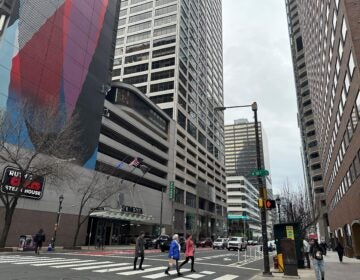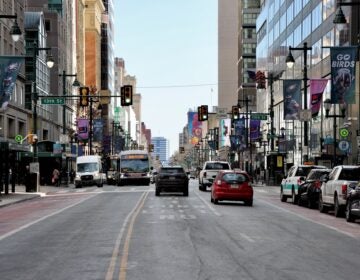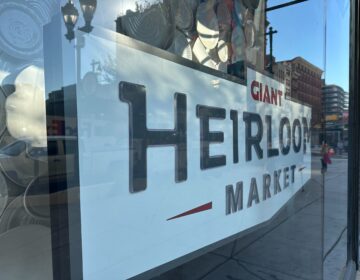Center City draws $2.8B in development — and fewer parking lots
Center City District’s latest report shows a booming real estate market. For Parkway Corp., the demand for land means a move away from operating parking.

An artist's rendering shows an 18-story Parkway Corp. development proposed for 2230 Market Street. (Parkway Corp./Center City District)
Building new parking in Center City just doesn’t make financial sense anymore, a Parkway Corp. executive said Tuesday.
Developers are moving away from the parking business because of the city’s high tax on commercial parking spaces and a strong market for new buildings, said Brian Berson, who leads real estate and development efforts for the Philly-based parking and real estate giant.
Evidence of the trend: An 18-story office tower Parkway is planning for 23rd and Market will have 47 private spaces and no public parking, and a Pod Hotel that Parkway recently completed near Rittenhouse Square has no parking at all.
Berson made his comments during a panel discussion sponsored by the Center City District and held at the Union League on Tuesday. It wasn’t the first time a company executive discussed its change in business strategy.
Berson’s boss, Rob Zuritsky, CEO of Parkway Corp, told the Philadelphia Business Journal in April that the company “wants to develop everything we can so we can get out of the parking business as quickly as we can.”
“I love the parking business, but the parking business is not profitable anymore,” Zuritsky said “We can’t make parking work, and we’re the parking guys.”
But that move away from parking comes with a cost, Berson said Tuesday.
“As we’re losing thousands of parking spaces every year in the city, through development, and through the pressures on the economics, we have congestion,” he said. “So we’re at the point where we see congestion as the enemy, and then maybe we need more creative solutions as what to do with all of these cars.”
The condition of Philadelphia streets came up repeatedly during the discussion of Center City’s growth, which was held to mark the release of CCD’s 2019 development report.
But even in the face of concerns about trash, congestion and bigger problems such as poverty, the report showcased a boom that has brought 23 projects totaling $2.8 billion to the area between Fairmount and Washington avenues since January 2018.
Another 18 projects worth $3 billion are under currently construction, the report said. An additional 21 projects worth $1 billion are planned or have been proposed.
A main driver of the boom is the decade-long national economic expansion, according to the report. Speakers also cited the trends of millennials and empty-nesters wanting to live near downtown and of corporate tenants seeking higher-quality office space.
The area’s population is up 22% since 2000, with 2,484 residential units added in 2018 alone. Another 1,941 units will be built this year.
$2.8 billion in development in 2018, 2019
As Center City grows and more people make it home, property owners and others in the area have begun to identify solutions for longtime problems such as a proliferation of dumpsters and loading docks.
In addition to worsening congestion, noise and litter, the trucks and dumpsters tend to turn alley streets into lifeless service corridors, said CCD executive director Paul Levy.
He applauded the creation of a unified trash-loading dock for the whole block around The Harper, a new mixed-use development at 19th and Chestnut.
Levy said CCD wants to introduce similar zoned trash collection to other downtown blocks. Jim Pearlstein of Pearl Properties, which built The Harper, said the effort has cut costs and reduced the number of daily truck trips.
“Keep in mind, a trash trip is not just 30 seconds. They pull in, they do a three-point turn, they back it up, they’re beeping, it’s 5 in the morning… People are complaining across the street, trucks are hitting the curb. Anything we can do to cut down on that and improve life in the area is good,” Pearlstein said.
At the same time, CCD’s report said Center City development remains robust, as demonstrated by the opening of the renovated Fashion District Philadelphia mall last week and a spate of other large building projects.
“With all of these challenges, Center City is doing great. We’re attracting people here,” Pearlstein said. “If we’re doing this well, in this day, think about what we can be. We have an opportunity to keep all these people here and continue to grow.”
Industry “cannot be passive” on 10-year abatement reform
Levy urged developers and business people in the audience at the Union League to work to save the tax abatement, which developers argue has spurred many projects that would not have happened otherwise. Several abatement-related bills have been proposed, and the issue is at the top of City Council’s fall agenda.
“It’s a highly likely possibility that council will seriously curtail the 10-year abatement,” Levy said. “People in [the development] industry cannot be passive on that issue.”
“We clearly understand the disparities in the city. This is a city with a 26% poverty rate, so we understand people look at development in Center City and wonder, does that include them? But I think the economic impact of this [abatement] is huge, in terms of construction jobs, permanent jobs, the growth of the tax base in the city,” he said.
Levy argued the city should keep the program as it is and pledge tax revenue from expiring abatements to production of affordable housing. That would provide “desperately needed” housing and link real estate growth to an important public purpose, he said.
Go west, developers say
The CCD report details 62 projects that were recently completed, are under construction, or are planned. The report is available online in an interactive format, a first.
Center City’s biggest completed project of 2019 is the Comcast Technology Center, which houses offices for 4,000 Comcast employees, a hotel, and restaurants. It is the largest development in Philadelphia history.
Among other notable projects are Aramark’s headquarters at 2400 Market St., the Hale Building at 1326 Chestnut St., the Studebaker Building at 667 N. Broad St., and the Independence Collection of three office buildings that includes the renovated Bourse.
The report highlights National Real Estate Development’s ongoing East Market project, which includes an office renovation, two new residential towers, and a hotel, as well as the neighboring Fashion District mall redeveloped by Pennsylvania Real Estate Investment Trust (PREIT). Together, those two projects are attempting to bring more life to the streetscape and encourage more tourists to visit the area between Independence Mall and City Hall.
Heather Crowell, PREIT executive vice president for strategy and communications, said the food court in the renovated mall’s transit concourse is already proving extremely successful, with Chickie & Pete’s so far drawing the most customers.
“There is more need. The food [traffic] is just off the charts,” Crowell said. “Just five days of operations and we can already tell some of these things are bursting at the seams, if you will.”
She noted that the Fashion District will be rolling out more attractions in the coming months: a music venue, a movie theater, coworking space, sidewalk café seating, and other attractions. In the next phase of development, PREIT may also build an apartment tower over the mall, she said, further boosting the neighborhood’s residential population.
Development also continues on West Market, with the completion of the Aramark building and Parkway’s plans for the new office tower, which would serve as headquarters for the law firm Morgan, Lewis & Bockius.
Berson said the new tower is part of a larger westward expansion that includes Brandywine Realty Trust’s massive Schuylkill Yard development.
Morgan Lewis “could have gone to existing real estate, they could have gone to a tax-incentivized site, but they were willing, as many other tenants in Philadelphia have been in the last few years, to look at a site that did not have tax advantages and at new construction, and all the economic pressures of those two decisions, to be in the right building, the right design and the right neighborhood,” he said.
WHYY is your source for fact-based, in-depth journalism and information. As a nonprofit organization, we rely on financial support from readers like you. Please give today.







